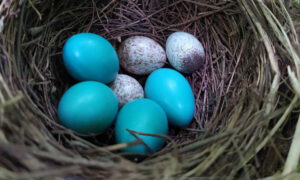Posted on November 6, 2023 in ASRC News

Study finds that experience plays an important role in helping host birds reject eggs placed in their nests by other bird species
It appears that humans aren’t the only animals conflicted about the demands of child rearing. In the bird world, there are several brood parasitic species that avoid the commitment altogether by laying their eggs in other, more attentive species’ nests. To survive the abandonment, the eggs of brood parasitic species have evolved over time to mimic the appearance of eggs laid by their unwitting foster parents. This evolutionary ability makes it harder for host birds to spot and reject foreign eggs from their nest to protect their genetic offspring from potential disease and other risks.
Evolutionary biologist Mark Hauber has made a career of studying the systems of brood parasitic birds, so he was curious to know if prior experience with these birds enables host birds to better spot and reject foreign eggs from their nest.
“This would help us understand whether learning plays a role in helping host birds recognize parasite eggs,” explained Hauber, whose paper on the subject was published in Evolution Letters shortly after he joined the ASRC as its executive director. “We also wanted to discern if the host bird’s learning impacts the course and speed of how parasitic birds’ eggs evolve over time to resemble those of host birds.”
To answer these questions Hauber and his research team executed a series of experiments using egg models of brown headed cowbirds—a parasitic species—and nesting American robins—a host species that are natural rejectors of cowbird eggs. At different intervals, the team placed brown spotted egg models, which closely resembled cowbird eggs, followed by dark blue egg models, which were more similar to the naturally light blue ones in the nests of wild robins incubating their own broods. They found that each exposure to the foreign cowbird-like eggs increased the robins’ subsequent ability to also reject the deep blue ones that they had not laid.
Based on the experiment, the researchers were able to develop a mathematical model to predict the speed of fine-tuned rejection decision making among the host birds and multigenerational egg mimicry in parasitic bird eggs.
“We found a coevolutionary relationship between the host birds’ increased learning and better egg mimicry among parasitic birds,” explained Hauber. “This is because the brood parasite eggs that skirt rejection are the ones that more closely resemble their host birds’ eggs, and that egg mimicry is passed on to subsequent generations.”
The team’s findings can help researchers better understand host-parasite bird systems and predict related evolutionary changes, said Hauber.
